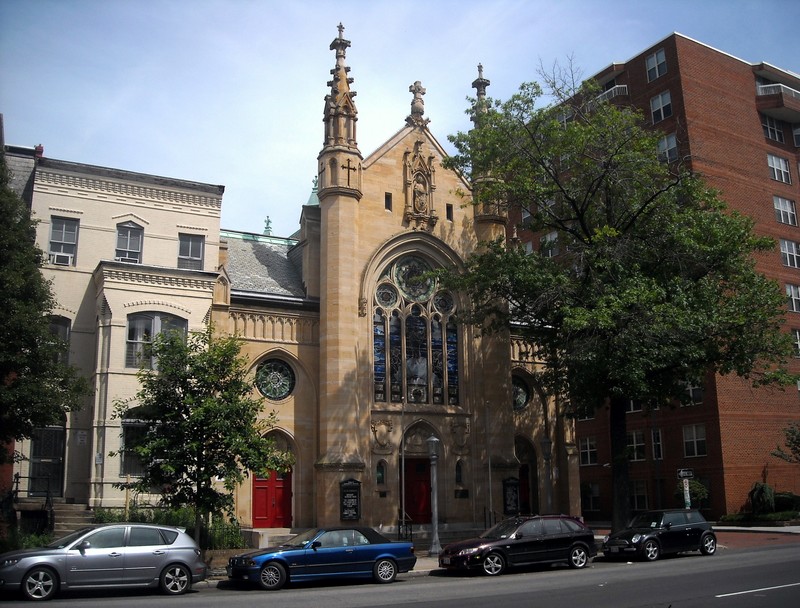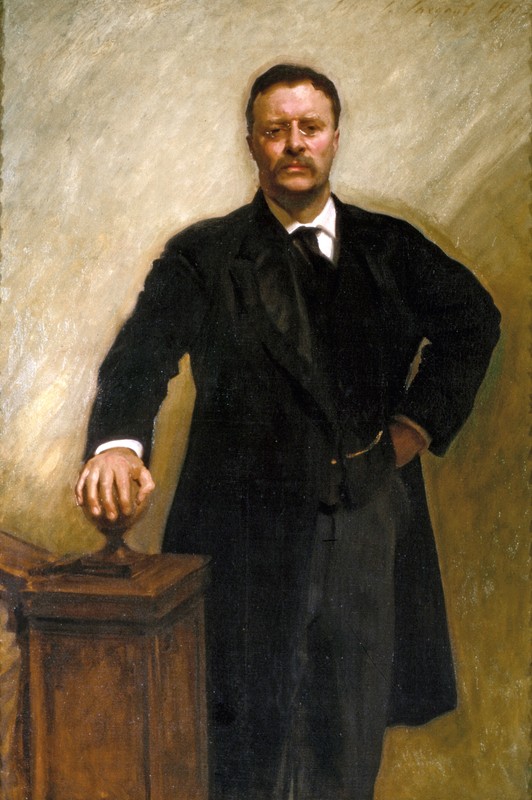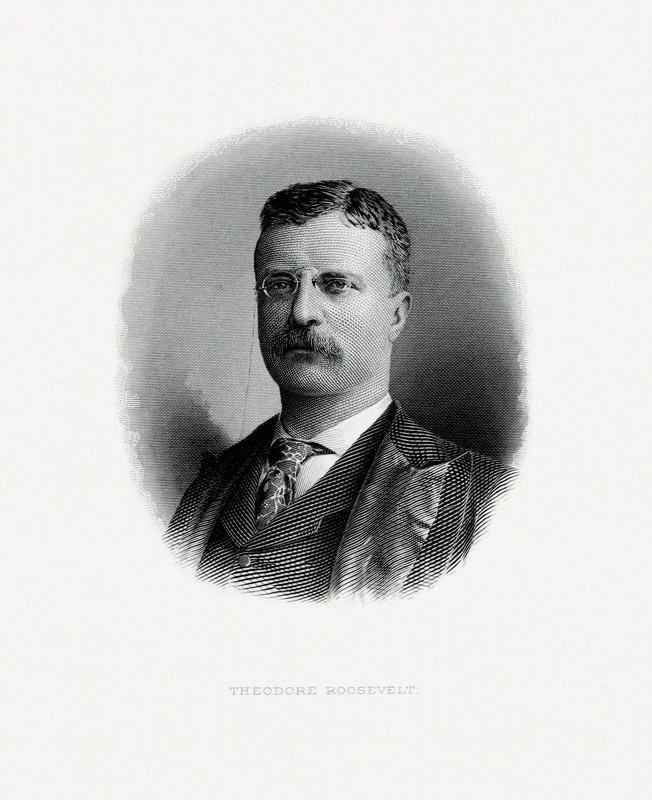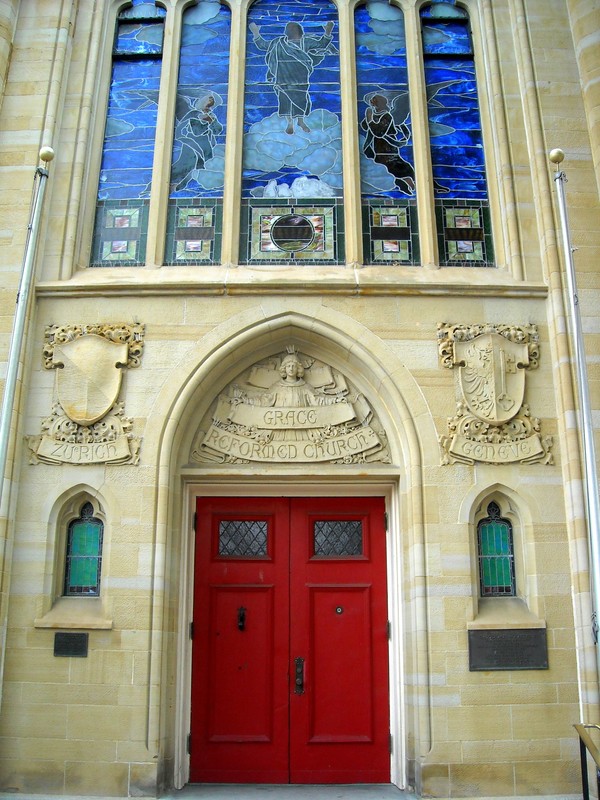Grace Reformed Church (Washington, D.C.)
Introduction
Text-to-speech Audio
Grace Reformed Church is a historic, Late Gothic Revival structure located in the Logan's Circle neighborhood of Washington, D.C. Constructed between 1892 and 1903, it is best known as the church attended by President Theodore Roosevelt during his administration. The church is affiliated with the United Church of Christ; traditional worship services include a focus on the historic creeds, Gospel preaching, as well as on choral and instrumental music. It was listed on the National Register of Historic Places, along with its Sunday School and Parish House, in 1991.
Images
Grace Reformed Church, located in the Logan's Circle neighborhood of Washington, D.C.; image by AgnosticPreachersKid - Own work, CC BY-SA 3.0, https://commons.wikimedia.org/w/index.php?curid=7484713

Official White House Portrait of Theodore Roosevelt By John Singer Sargent; image courtesy of the The White House Historical Association

Portrait of Theodore Roosevelt; image courtesy of The Bureau of Engraving and Printing - Restoration by Godot13, Public Domain, https://commons.wikimedia.org/w/index.php?curid=33965290

Facade of the Grace Reformed Church, showing the carved stone shields; image by AgnosticPreachersKid at en.wikipedia, CC BY-SA 3.0, https://commons.wikimedia.org/w/index.php?curid=18212634

Backstory and Context
Text-to-speech Audio
The history of the Grace Reformed Church can be traced back to October 7, 1877, when it was organized with 14 charter members. Originally, the church was affiliated with the Reformed Church in the United States, though it later merged with the Evangelical Synod of North America (ESNA) to form the Evangelical and Reformed Church (E&R) prior to 1957. It is now associated with the United Church of Christ (U.C.C). The Maryland Classis, the region's Reformed Church body of governance, supported its construction as a mission church.
The first church built on the site of the current building was a chapel in the Queen Anne style. It was constructed in 1881 by the Maryland Classis. By 1899, the Maryland Classis began to raise funds for a new structure to serve as a national symbol for the denomination. The endeavor received a boost when then-President Theodore Roosevelt chose to this site as his primary place of worship.
Grace Reformed Church is particularly notable for its most famous attendee, the 26th President of the United States. Roosevelt was originally a member of the Dutch-American RCA and adherent to Dutch Calvinism. As such, he preferred Reformed Churches to all others. He reportedly once said of the matter: "I take a sentimental satisfaction in worshiping in the Church of my fathers."1 In 1901, soon after he took office, Reverend Dr. J.M. Schick, the pastor of Grace Reformed Church, invited Roosevelt to attend services there. Roosevelt would do so throughout his administration, and his regular pew is still extant today.
Designed in the Late Gothic Revival Style by architects Paul J. Pelz and A.A. Ritcher, the church's properties include .2 acres of land. Grace Reformed Church was constructed between 1892 and 1903; President Roosevelt himself laid the cornerstone and spoke at the dedication:
The church itself is built from stone, brick, iron, copper, tin, and slate, with the Amherst Grey Canyon stone facing. The exterior is decorated with stone shields of Zurich and Geneva and stone heads of the knight and burgher by the stone carver James F. Earlev. The sculptures are symbolic of key influences on history of the Reformed Church. Inside are 7 stained glass windows depicting scenes from the life of Jesus Christ and a historic organ. Above the altar is a large mosaic of the Ascension into Heaven.
The Sunday School was built in 1911/12, and was also designed by Pelz. A set of double doors within the foyer lead to the "Roosevelt Room," which is used for meetings and social events. The cornerstone laid by the 26th President is incorporated into the wall on the east side. The room also contains memorabilia related to Roosevelt. In 1892, W. H. H. Knight, a member of the congregation, erected the Parish House. All three structures were added to the NHRP in 1991.
The first church built on the site of the current building was a chapel in the Queen Anne style. It was constructed in 1881 by the Maryland Classis. By 1899, the Maryland Classis began to raise funds for a new structure to serve as a national symbol for the denomination. The endeavor received a boost when then-President Theodore Roosevelt chose to this site as his primary place of worship.
Grace Reformed Church is particularly notable for its most famous attendee, the 26th President of the United States. Roosevelt was originally a member of the Dutch-American RCA and adherent to Dutch Calvinism. As such, he preferred Reformed Churches to all others. He reportedly once said of the matter: "I take a sentimental satisfaction in worshiping in the Church of my fathers."1 In 1901, soon after he took office, Reverend Dr. J.M. Schick, the pastor of Grace Reformed Church, invited Roosevelt to attend services there. Roosevelt would do so throughout his administration, and his regular pew is still extant today.
Designed in the Late Gothic Revival Style by architects Paul J. Pelz and A.A. Ritcher, the church's properties include .2 acres of land. Grace Reformed Church was constructed between 1892 and 1903; President Roosevelt himself laid the cornerstone and spoke at the dedication:
This church is consecrated here to-day to duty and service, to the worship of the Creator, and to an earnest effort on our part so to shape our lives among ourselves and in relation to the outside world that we may feel that we have done our part in ringing a little nearer the day when there shall be on this earth a genuine brotherhood of man.2
The church itself is built from stone, brick, iron, copper, tin, and slate, with the Amherst Grey Canyon stone facing. The exterior is decorated with stone shields of Zurich and Geneva and stone heads of the knight and burgher by the stone carver James F. Earlev. The sculptures are symbolic of key influences on history of the Reformed Church. Inside are 7 stained glass windows depicting scenes from the life of Jesus Christ and a historic organ. Above the altar is a large mosaic of the Ascension into Heaven.
The Sunday School was built in 1911/12, and was also designed by Pelz. A set of double doors within the foyer lead to the "Roosevelt Room," which is used for meetings and social events. The cornerstone laid by the 26th President is incorporated into the wall on the east side. The room also contains memorabilia related to Roosevelt. In 1892, W. H. H. Knight, a member of the congregation, erected the Parish House. All three structures were added to the NHRP in 1991.
Sources
1. "Grace Reformed Church (Washington, D.C.)." Wikipedia - The Free Encyclopedia. Accessed January 12, 2017. http://en.wikipedia.org/wiki/Grace_Reformed_Church_(Washington,_D.C.).
2. The Address of President Roosevelt at the Dedication of Grace Reformed Church, Washington, D.C." Reformed Church Messenger. June 11, 1903 in ibid.
"Historic Site." Grace Reformed Church, Washington DC. Accessed January 12, 2017. https://gracereformedchurchdc.org/building-history/.
2. The Address of President Roosevelt at the Dedication of Grace Reformed Church, Washington, D.C." Reformed Church Messenger. June 11, 1903 in ibid.
"Historic Site." Grace Reformed Church, Washington DC. Accessed January 12, 2017. https://gracereformedchurchdc.org/building-history/.
